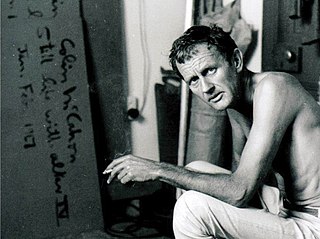
Peter McIntyre was a New Zealand painter and author who rose to prominence as a result of artwork produced in his capacity as an official war artist during the Second World War.

Colin John McCahon was a prominent New Zealand artist whose work over 45 years consisted of various styles, including landscape, figuration, abstraction, and the overlay of painted text. Along with Toss Woollaston and Rita Angus, McCahon is credited with introducing modernism to New Zealand in the mid-20th century. He is regarded as New Zealand's most important modern artist, particularly in his landscape work.

Hocken Collections (Māori: Uare Taoka o Hākena, formerly the Hocken Library) is a research library, historical archive, and art gallery based in Dunedin, New Zealand. Its library collection, which is of national significance, is administered by the University of Otago.

Rita Angus, a New Zealand painter, has a reputation - along with Colin McCahon and Toss Woollaston - as one of the leading figures in twentieth-century New Zealand art. She worked primarily in oil and water colour, and became well-known for her portraits and landscapes.
Sir Mountford Tosswill "Toss" Woollaston was a New Zealand artist. He is regarded as one of the most important New Zealand painters of the 20th century.

Charles Orwell Brasch was a New Zealand poet, literary editor and arts patron. He was the founding editor of the literary journal Landfall, and through his 20 years of editing the journal, had a significant impact on the development of a literary and artistic culture in New Zealand. His poetry continues to be published in anthologies today, and he provided substantial philanthropic support to the arts in New Zealand, including by establishing the Robert Burns Fellowship, the Frances Hodgkins Fellowship and the Mozart Fellowship at the University of Otago, by providing financial support to New Zealand writers and artists during his lifetime, and by bequeathing his extensive collection of books and artwork in his will to the Hocken Library and the University of Otago.

Landfall is New Zealand's oldest extant literary magazine. The magazine is published biannually by Otago University Press. As of 2020, it consists of a paperback publication of about 200 pages. The website Landfall Review Online also publishes new literary reviews monthly. The magazine features new fiction and poetry, biographical and critical essays, cultural commentary, and reviews of books, art, film, drama, and dance.
Gretchen Albrecht is a New Zealand painter and sculptor.

King Edward Technical College is a former school and technical college in Dunedin, New Zealand. The college was established in 1889 as the Dunedin Technical School when the Caledonian Society instigated night education classes.

James McLauchlan Nairn was a New Zealand painter who strongly influenced New Zealand painting in the late 19th century. He believed in en plein air or painting outdoors.
Fitzclarence Anstey John Caselberg was a New Zealand writer.
Helen Flora Victoria Scales (1887–1985) was a notable New Zealand artist. She was born in Lower Hutt, Wellington, New Zealand in 1887.

Doris More Lusk was a New Zealand painter, potter, art teacher, and university lecturer. In 1990 she was posthumously awarded the Governor General Art Award in recognition of her artistic career and contributions.
Wystan Tremayne Le Cren Curnow is a New Zealand art critic, poet, academic, arts administrator, and independent curator. He is the son of Elizabeth Curnow, a painter and printmaker, and poet Allen Curnow.

Barry Lett Galleries was a dealer gallery focused on contemporary New Zealand art that operated in Auckland in the 1960s and 1970s.
Helen Hitchings was a New Zealand art dealer, best known for the short-lived but influential eponymous dealer gallery she opened in Wellington in 1949.

Peter Joseph John McLeavey was a New Zealand art dealer and advocate based in Wellington.
The Group was an informal but influential art association formed in Christchurch, New Zealand in 1927. Initially begun by ex-students from Canterbury College of Art, its aim was to provide a freer, more experimental alternative to the academic salon painting exhibitions of the Canterbury Society of Arts. The Group exhibited annually for 50 years, from 1927 to 1977, and it was continuously at the forefront of New Zealand art's avant-garde scene.
Anna Margaret Frances Caselberg was a New Zealand painter.
Anne McCahon was a New Zealand artist who emerged as part of a lively South Island art scene in the 1930s, often taking trips into the countryside on painting excursions with fellow artists Doris Lusk, Toss and Edith Woollaston, and her eventual husband, Colin McCahon. Hamblett studied and first exhibited in Dunedin in the 1930s and '40s. Her artistic output was circumscribed after she married fellow modernist artist Colin McCahon in 1942. Her work has rarely been exhibited since her early Dunedin painting days and her first solo show took place posthumously in 2016 at Te Uru Waitakere Contemporary Gallery.











